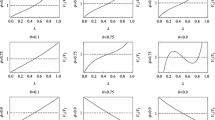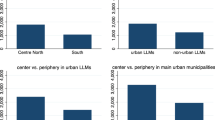Abstract
Standard models of the “new economic geography” predict that costs-of-living are low in the central and high in peripheral region, due to the fact that consumers in the periphery have to bear transportation cost for manufacturing varieties. In reality, however, only some goods are cheaper in economic centres, whereas the overall costs-of-living (including housing costs) tend to be higher. In this paper we use an analytically tractable economic geography model with an immobile housing stock, so that regional agglomeration drives up housing prices. We show that a core-periphery structure can endogenously emerge in which the core is the more expensive area in equilibrium. We also analyse the efficiency of spatial cost-of-living differences and augment the model to include an exogenous regional difference in the form of a consumption amenity.
Similar content being viewed by others
References
Baldwin R, Forslid R, Martin P, Ottaviano G and Robert-Nicoud F (2003). Economic geography and public policy. Princeton University Press, Princeton
Curran L, Wolman H, Hill E and Furdell K (2006). Economic wellbeing and where we live: Accounting for geographical cost-of-living differences in the US. Urban Stud 43: 2443–2466
Charlot S, Gaigné C, Robert-Nicoud F and Thisse J-F (2005). Agglomeration and welfare: the core–periphery model in the light of Bentham, Kaldor, and Rawls. J Pub Econ 90: 325–347
Deaton A and Muellbauer J (1986). Economics and consumption behavior. MIT Press, Cambridge
Forslid R and Ottaviano G (2003). An analytically solvable core-periphery model. J Econ Geog 3: 229–240
Fujita M, Krugman P and Venables A (1999). The spatial economy. Cities, regions, and international trade. MIT Press, Cambridge
Glaeser E and Maré D (2001). Cities and skills. J Labor Econ 19: 316–342
Helpman E (1998). The size of regions. In: Pines, D, Sadka, E and Zilcha, I (eds) Topics in public economics, Cambridge University Press, Cambridge
Krugman P (1991). Increasing returns and economic geography. J Polit Econ 99: 483–499
Laffont J (1987). Externalities. In: Eatwell, J, Milgate, M and Newman, P (eds) The new palgrave, Macmillan Press, London
Ludema R and Wooton I (2000). Economic geography and the fiscal effects of regional integration. J Int Econ 52: 331–357
Ottaviano G and Thisse J-F (2001). On economic geography in economic theory: increasing returns and pecuniary externalities. J Econ Geog 1: 153–179
Ottaviano G, Tabuchi T and Thisse J-F (2002). Agglomeration and trade revisited. Int Econ Rev 43: 409–435
Pflüger M (2004). A simple, analytically solvable, Chamberlinian agglomeration model. Reg Sci Urban Econ 34: 565–573
Pflüger M, Südekum J (2007) Integration, agglomeration and welfare. J Urban Econ (forthcoming)
Roback J (1982). Wages, Rents and the Quality of Life. J Pol Econ 90: 1257–1278
Südekum J (2006). Agglomeration and regional costs-of-living. J Reg Sci 46: 529–543
Tabuchi T (1998). Urban agglomeration and dispersion: a synthesis of Alonso and Krugman. J Urban Econ 44: 333–351
Tabuchi T (2001). On interregional price differentials. Jpn Econ Rev 52: 104–115
Tabuchi T and Thisse J-F (2006). Regional specialization, urban hierarchy and commuting costs. Int Econ Rev 47: 1295–1317
Tabuchi T and Thisse J-F (2002). Taste heterogeneity, labor mobility and economic geography. J Dev Econ 69: 155–177
Tabuchi T, Thisse J-F and Zeng D (2003). On the number and size of cities. J Econ Geog 5: 428–448
Yankow J (2006). Why do cities pay more? An empirical examination of some competing theories of the urban wage premium. J Urban Econ 60: 139–161
Author information
Authors and Affiliations
Corresponding author
Rights and permissions
About this article
Cite this article
Südekum, J. Regional costs-of-living with congestion and amenity differences: an economic geography perspective. Ann Reg Sci 43, 49–69 (2009). https://doi.org/10.1007/s00168-007-0201-z
Received:
Accepted:
Published:
Issue Date:
DOI: https://doi.org/10.1007/s00168-007-0201-z




